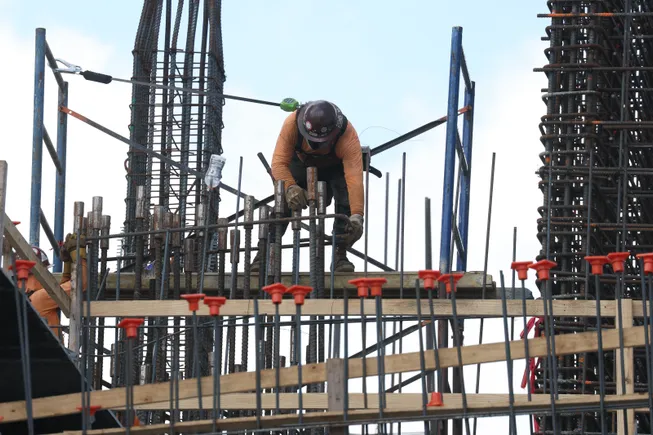Mason Hester and Austin Moorman are construction attorneys in the Dallas office of law firm Munsch Hardt. Opinions are the authors’ own.
The construction industry, and the larger market itself, is facing uncertainty in light of the ever-evolving tariff landscape. This confusion is unsurprising given the institution, and reversal, of varied tariffs over the last several months.

Mason Hester
Courtesy of Munsch Hardt
The threat of increased prices has caused many contractors and subcontractors to begin increasing their prices by as much as 20%, while others are delaying potential contracts until the situation stabilizes. A contractor who entered into a contract on April 1 , 2025 may have done so on the basis of significantly different pricing than exists today.
Yet, business just can’t stop. There is a need for parties in the construction industry to continue to effectively price work and enter into commercially viable contracts with owners. So what can contractors do to protect themselves from the potential increased project time and costs caused by these tariffs?
Cost plus and GMP
In this case, cost-plus contracts are your friend. Under this type of agreement, you can argue the tariffs are a part of the cost of the work and materials, and pass those costs onto the owner.

Austin Moorman
Courtesy of Munsch Hardt
It is important to remember, however, that even in a cost-plus contract, the contractor arguably has a duty to use reasonable efforts to minimize the costs incurred. Care should also be taken to review the contract to make sure the tariffs do not fall under an exception to the list of compensable costs.
This is where the details matter. If the contract has a guaranteed maximum price component and the increased costs cause you to exceed it, you could end up eating them.
Outside of that, tariffs can also delay the project schedule due to material shortages. In that case, the contract’s force majeure clause should be reviewed as another potential avenue for relief.
Lump sum
Existing lump sum contracts — also known as “fixed” or “stipulated” sum contracts — present a more challenging situation. Generally speaking, in Texas if a contractor agrees to construct an improvement for a fixed sum, the contractor assumes all risks of subsequent price increases in the work. The flipside is they reap the benefits of a price decrease.
In those cases, you should review the contract for a price escalation clause, which became increasingly popular during the COVID-19 pandemic.
Standard industry contract options
There are other potential avenues for relief, particularly in commonly used industry contracts.
For example, in the American Institute of Architects A201 contract covering general conditions, a common template used by owners and contractors alike, the word “tariff” is never mentioned.
But Section 3.6 states “The Contractor shall pay sales, consumer, use and similar taxes for the Work provided by the Contractor that are legally enacted when bids are received or negotiations concluded …”
That could be a huge out right there. This language provides a basis for contractors to argue a tariff is a type of tax and the contractor is only responsible for taxes in existence at the time the bid was finalized, not those arising later.
Other options
Similarly, A201 contains a force majeure clause. While in an ideal world, the word “tariff” would be included in this clause and provide an adjustment for the contract price, one could argue tariffs fall within the force majeure’s scope.
We’re not saying it will be a layup, but it is a possibility. The answer will depend on the words surrounding the FM clause, depending on the facts of each case and whether tariffs are within the same type of damages envisioned by the “labor disputes,” “fire” or “other causes beyond the Contractor’s control” mentioned in the clause.
If none of these contractual provisions are present, the owner may still be willing to execute a change order. It’s at least worth asking the question. If the owner’s unwilling, you still may be able to get an exception under the guidelines provided by the Department of Commerce as a last resort.
Gather your data now
Regardless of what’s in the contract, contractors need to provide detailed documentation relating to the price increases to support their argument. That could include statements from suppliers relating to the increased costs caused by tariffs, as well as evidence the contractor took all possible steps to minimize costs.
If you haven’t signed a contract yet, the above represent some of the contract provisions you want to look for.
Also, if you’re still in negotiations, make sure your force majeure and price escalation clauses include the word “tariffs.” Even broader language such as “any other actions by governmental authorities” should also be considered.
And all of these provisions should “flow down” into the subcontracts —- namely, sections stating that the subcontractors will get additional time and money resulting from tariffs, but only to the extent the owner grants this to the contractor.
This situation is rapidly changing and is still a relatively new, evolving area of the law. The above is only meant to provide a quick summary. But when these issues arise for you and your company, if you at least know what to look for, you’ll be one step ahead for the inevitable call with your attorney.
View the original article and our Inspiration here


Leave a Reply